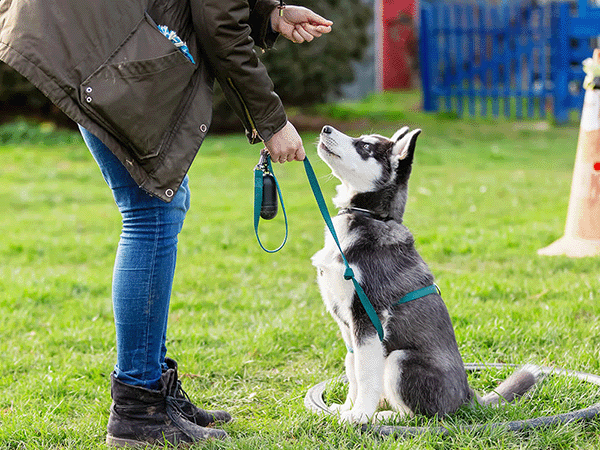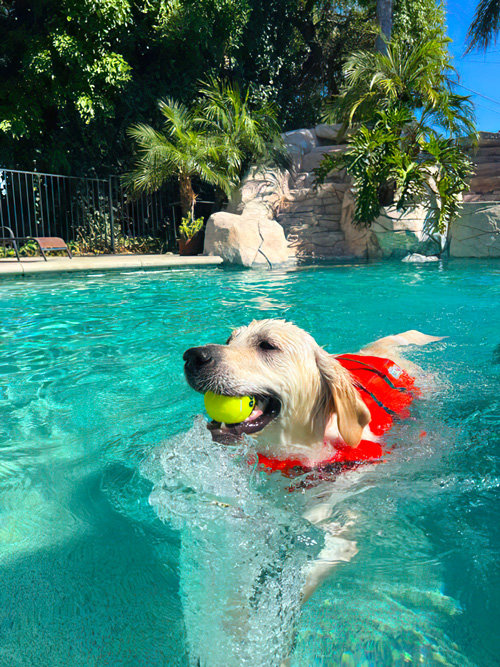Dog Car Safety: Essential Tips for Safe Travels

We've all seen that classic image of a happy dog with its head out the car window. It's cute, right? But let's be real, dog car safety is no joke. An unrestrained pet can be a serious distraction, putting everyone in the car at risk. This guide covers simple, actionable steps to keep your dog safe and happy on the road, from choosing the right restraint to making the journey enjoyable for all.
Unfortunately, though, unrestrained riding is not the safest situation—for you, for your pup, or for other drivers on the road.
Here’s how to be smart while driving with your furry friend. We cover:
- The risks of distracted driving
- Why you should restrain your dog on the road
- Safe ways to secure your dog in the car
- Common questions about traveling with dogs
- Some of our favorite places to adventure with our canine companions
Is Distracted Driving a Danger to Your Dog?
The National Institute of Health cites driving with pets as a major risk factor for car accidents. According to a Progressive survey, a significant proportion of drivers engage in unsafe behaviors when they have dogs in the vehicle.
When you’re behind the wheel, your canine companion—and all your fellow drivers on the road—need you to pay attention!
Here are the biggest ways dogs cause distracted driving.
Key Takeaways
- Safe travels start with restraints: Harnesses, crates, or barriers protect your dog during accidents and minimize driver distractions, making every journey safer.
- Happy travels mean planning ahead: Consider your dog's personality and needs for any trip. Help them adjust to car rides, take frequent breaks, and address any motion sickness for smoother travels.
- Adventure awaits!: With safe and comfortable car travel sorted, explore new places with your pup! Sniffspot offers private dog parks, and you can also discover dog-friendly trails, beaches, and events.
Reduced attention
Having a dog in the car can be distracting. Our pets might move around, bark, or seek our affection. This can divert focus away from the road and increase the risk of accidents.
Impaired visibility
A dog in the car can obstruct your view by blocking your rearview mirror, sitting on your lap, or moving in a way that hinders your line of sight.
Sudden movements
Dogs can make sudden movements or react to external stimuli like other vehicles or pedestrians. These unexpected actions can startle you, resulting in erratic driving behavior.
Stress and anxiety
Dogs can become anxious, or agitated during car rides. This behavior can further distract you—and the stress can also affect your pet’s well-being.
Reduced reaction time
Distracted driving can impair your reaction time. This makes it difficult to respond quickly to changes in traffic or road conditions.

Why Use a Dog Car Restraint?
Here’s why restraining your dog in the car—with one of a number of pet travel products like safety harnesses or hard-sided crates—is important.
Minimize driver distractions
Unrestrained dogs can be a significant distraction to the driver. They may move around the vehicle, jump onto your lap, or seek attention, diverting your focus away from the road and other critical driving tasks.
Reduce the risk of accidents
Distracted driving can lead to accidents, as your reaction time and ability to respond to changing traffic conditions may be compromised. Restraining your dog helps you maintain better control of the vehicle.
Prevent injury
In the event of a sudden stop, collision, or even a minor accident, an unrestrained dog can become a dangerous projectile. This not only endangers your pet—it can also cause injury to you and other passengers.
Protect your pet
A restrained dog is less likely to escape or be injured during a car accident. It also prevents your pet from jumping out of an open window or door when the car is in motion.
Comply with local safety laws
In some places, it is a legal requirement to restrain pets while in a moving vehicle. Failing to do so can result in fines and penalties.
Avoid startling behavior
Dogs can react to external stimuli, such as other vehicles, pedestrians, or animals, in a way that startles the driver. This sudden behavior can lead to unsafe driving conditions.
Protect Passengers in Case of an Accident
Unrestrained Pets Become Projectiles
In the event of a sudden stop or collision, an unrestrained dog can become a dangerous projectile. The Humane Society of the United States emphasizes the importance of securing your pet for everyone's safety. An unrestrained pet not only endangers itself, but also poses a significant risk of injury to everyone else in the vehicle. The impact of a loose pet in a crash can be substantial, potentially causing serious harm.
Legal Requirements for Pet Restraints Vary by State
Beyond safety concerns, there are legal aspects to consider when traveling with your dog. Regulations regarding pet restraints in vehicles differ from state to state. In some areas, restraining your pet while driving is legally required, and failing to do so could result in fines. It's wise to check the specific laws in your state and any state you’re traveling through. This way, you’ll comply with local regulations and keep your furry friend safe and legal.
Safe Ways to Secure Your Dog in the Car
Restraint is essential to keep your dog safe in the car, and there are several safe ways to do so. The method you choose depends on your dog’s size, temperament, and your personal preferences.
Here are some safe pet products to restrain your dog in the car.
Dog seat belt or harness
A dog seat belt or harness is specifically designed to secure your dog in the car. These devices attach to your car’s seat belt system, and some have adjustable straps to allow your dog to sit or lie down comfortably. Ensure that you choose a high-quality product that is appropriate for your dog’s size and weight.
Dog crate or pet carrier
A sturdy dog crate or carrier can be an excellent option, especially for smaller dogs. Make sure the crate is appropriately sized for your dog and secured in the car to prevent it from shifting during a sudden stop or collision.
Positioning and Securing Crates/Carriers
Placement and security are key when using a crate in the car. A loose crate can become a dangerous projectile in an accident. The Center for Pet Safety recommends properly fitting and testing any restraint system. For optimal safety, place the crate on the floor of the backseat or cargo area, preferably up against the back seat. Secure it with seatbelts or cargo straps to prevent shifting during travel. If your vehicle has tie-down loops or anchor points in the cargo area, use them to further stabilize the crate.
Choosing the Right Size Crate
A crate that's too small restricts your dog's movement and can cause discomfort and anxiety. A crate that’s too large won't offer adequate protection in a sudden stop. The American Veterinary Medical Association (AVMA) recommends a crate large enough for your dog to stand, turn around, and lie down comfortably. Consider your dog's size and the space available in your vehicle. A Reddit discussion highlights how larger dogs may require larger crates or different restraint systems. When in doubt, it's always best to err on the side of a slightly larger crate to ensure your dog's comfort and well-being during travel.
Pet barrier
If you have a larger vehicle like an SUV or a station wagon, you can install a pet barrier to keep your dog in a specific area of the car, such as the cargo area. This pet safety product prevents your dog from moving into the passenger area and distracting the driver.
Back seat hammock
A back seat hammock is a type of seat cover that extends over the back seat and the rear of the front seats. It creates a barrier that can help keep your dog in the back seat and protect your car’s upholstery.
You should never let your dog ride in the passenger seat for crash safety reasons—the airbags carry significant risk of injury to smaller animals. Truck beds are a no go, too.
Crash-tested products
Look for products that have undergone crash tests and are certified for safety. Manufacturers have designed these restraints to withstand the forces involved in a car accident and provide the highest level of protection for your dog—and pet safety experts recommend them as the best option.
Choosing the Right Restraint for Your Dog
Regardless of the method you choose, it’s essential to ensure that your dog is comfortable and properly secured. Always follow the manufacturer’s instructions for installation and use of any restraint system, and make adjustments as needed to ensure a secure fit.
You should also get your dog used to their restraint system gradually—this is called counter conditioning or acclimation training—to reduce anxiety and make car trips a positive experience.
Remember that the specific choice of restraint may depend on your dog’s size, behavior, and individual needs. The most important thing is to prioritize safety standards for both you and your pet when traveling in a car.

Additional Car Safety Tips for Dogs
Keeping your dog safe in the car goes beyond just using a restraint. Here are a few more tips to ensure a smooth and secure ride.
Never Allow Your Dog to Ride in the Driver's Lap
It might seem cozy to have your furry friend on your lap, but it's incredibly dangerous. An unrestrained dog becomes a dangerous projectile in an accident, posing a risk to everyone in the vehicle. A Reddit discussion highlights the potential dangers of unrestrained pets in cars.
Never Allow Your Dog to Ride With Its Head Out the Window
As tempting as it is to let your dog enjoy the breeze with their head out the window, it's best avoided. This can lead to injuries from flying debris or even the dog jumping out, according to the Humane Society of the United States.
Use Child Locks
If your dog is secured in the backseat, engage the childproof locks. This simple step, recommended by the American Kennel Club, prevents curious paws from accidentally opening a window or door.
Consider Temperature Dangers
Temperature extremes can be dangerous for dogs left in cars. Always be mindful of the weather and take precautions to protect your pet.
How Quickly Temperatures Rise in Parked Cars
Even on mildly warm days, a parked car can quickly become an oven. The American Veterinary Medical Association warns that the temperature inside a car can rise by 20°F in just 10 minutes.
Cold Weather Risks
Cold weather also poses risks, especially for young, old, sick, or thin dogs. The AVMA emphasizes the vulnerability of these pets to cold temperatures in cars.
Never Leave Pets Unattended in a Vehicle
The simplest and most important rule: never leave your pet unattended in a vehicle. The Humane Society stresses this point, as temperature fluctuations and other dangers can quickly create a hazardous situation.
4) Other common questions about traveling with dogs
Tips for Traveling With Your Dog (Beyond Car Safety)
Of course, traveling with your dog involves more than just car rides. Whether you’re planning a cross-country road trip or a quick visit to a local dog park, it’s important to keep your pet’s safety and well-being in mind. Here are some tips for making travel enjoyable for both of you.
Should You Bring Your Cat?
While this post focuses on dogs, remember that every pet has unique needs. Cats, for example, often experience higher stress levels during travel. Consider your pet's individual temperament and consult your veterinarian for advice. If your cat is prone to anxiety, it might be best to leave them with a trusted pet sitter.
Consider Your Pet's Temperament and Trip Length
Just like humans, some dogs are natural travelers, while others find the experience stressful. A dog who gets carsick or anxious on short trips might not be the ideal companion for a long road trip. As Sniffspot points out, anxious or agitated behavior in the car can distract you and negatively impact your pet’s well-being. Consider your dog’s personality and the length of your trip when making travel plans.
Air, Ship, and Train Travel Tips
If your travels involve planes, trains, or ships, careful planning is essential. Here's what you need to know:
Airline Rules and Restrictions
Airlines have specific regulations regarding pet travel, including size and breed restrictions. Check these rules well in advance to avoid last-minute surprises. Be prepared for additional fees and paperwork, and book your pet's spot early, as space for animals is often limited.
Prioritizing In-Cabin Travel
Whenever possible, prioritize in-cabin travel for your pet. This allows you to keep a close eye on them and ensures they're in a climate-controlled environment. Familiarize yourself with the airline's in-cabin pet carrier requirements and make sure your carrier meets the specifications.
Cargo Travel Precautions
If in-cabin travel isn't an option, research the airline's cargo policies carefully. Ensure your pet is healthy and up-to-date on vaccinations before traveling in cargo. Choose direct flights whenever possible to minimize the time your pet spends in transit, and avoid extreme temperatures.
International Travel Regulations
International travel with pets involves additional regulations and paperwork. Research the specific requirements of your destination country well in advance. Some countries require quarantine periods, specific vaccinations, or health certificates. Also, be aware that some countries have legal requirements for restraining pets in moving vehicles, so be sure to pack appropriate restraints.
Veterinary Checkup and Vaccinations
Before any trip, schedule a checkup with your veterinarian. Ensure your pet's vaccinations are current and discuss any potential health concerns related to travel. Your vet can also provide advice on medications for motion sickness or anxiety.
Proper Identification
Make sure your pet wears a collar with current identification tags, including your name, phone number, and address. Microchipping is also crucial, as it provides a permanent form of identification. Double-check that your contact information associated with the microchip is up-to-date.
Frequent Stops for Exercise and Elimination
During long car trips, plan for frequent stops. Give your pet opportunities to stretch their legs, relieve themselves, and burn off some energy. Carry a leash, poop bags, and water for your dog, and choose safe, designated areas for these stops.
What if Your Dog Gets Car Sick?
Motion sickness in dogs can be uncomfortable for both your pet and you as their owner. If your dog gets motion sick in the car, there are several steps you can take to help alleviate their symptoms and make car rides a more pleasant experience:
Consult your veterinarian
If your dog experiences severe or persistent motion sickness, it’s a good idea to consult your veterinarian. They can rule out any underlying health issues and recommend appropriate treatments or medications.
Gradual acclimation
Start by taking short car trips to help your dog become accustomed to the motion and reduce anxiety associated with car travel. Gradually increase the duration of these trips as your dog becomes more comfortable.
Travel on an empty stomach
Avoid feeding your dog right before a car trip. Some dogs are less likely to experience motion sickness if their stomach is empty.
Proper ventilation
Ensure the car is well-ventilated, as fresh air can help reduce motion sickness symptoms. Crack a window or use the car’s air conditioning system.
Car seat position
Keep your dog in a position where they can see out of the car window. This can help reduce motion sickness because they can better orient themselves with the movement of the car.
Secure your dog
Use a secure and comfortable restraint system to keep your dog in one place in the car. This can help reduce motion-induced stress and discomfort.
Take shorter trips
If your dog continues to experience motion sickness, consider shorter trips at first, gradually extending the duration as they become more comfortable.
Minimize distractions
Reduce external stimuli inside the car that may contribute to motion sickness. Keep the interior of the car calm and minimize sudden stops or sharp turns.
Desensitization
You can work on desensitizing your dog to the car by simply sitting in it with them when it’s parked without the engine running. Offer treats and praise to create positive associations with the car.
Anti-nausea medications
In severe cases, your veterinarian may prescribe or recommend over-the-counter anti-nausea medications that are safe for dogs. Always follow your vet’s guidance when using medications.
Natural remedies
Some natural remedies like ginger or peppermint may help alleviate motion sickness symptoms in dogs. Consult your veterinarian before using any natural remedies to ensure they are safe for your specific pet.
Remember that every dog is unique, and what works for one pet parent may not work for another. It may take time and patience to find the right combination of strategies to help your dog overcome motion sickness. The goal is to make car rides as stress-free and comfortable as possible for your pet.
How to Handle a Reactive Dog in the Car
Does your dog become agitated or anxious when they see other dogs, people, or objects while in a moving vehicle? We’ve got you covered.
Restrain Your Dog
Ensure your dog is safely restrained while in the car. Use a seatbelt harness or a crate to prevent them from jumping around or potentially interfering with your driving.
Reduce stimuli via environmental management
In the short term, you can also reduce your dog’s exposure to triggers by using window shades or covering the windows (or securing them in a crate they can’t see out of). This can help reduce their anxiety during car rides.
Provide distractions
Give your dog something to do during car rides, like interactive toys or puzzles, to keep their mind engaged and minimize their focus on external stimuli. This is a form of management like reducing their physical view.
Seek professional dog reactivity help
Consider consulting a professional dog trainer or behaviorist who specializes in reactivity. They can provide you with personalized guidance and training techniques to address your dog’s specific issues.
Be patient and consistent when working on car ride reactivity with your dog. Every dog is different, and progress may take time. The key is to create positive associations with car rides and gradually desensitize and counter condition your dog to the triggers that cause their reactivity.
What if Your Dog Dislikes the Car?
If your dog simply doesn’t like the car and exhibits signs of fear or discomfort during car rides, you can take steps to help them become more comfortable and make car travel a less stressful experience. Here are some strategies to start with.
Make the car a positive place
Make the car a comfortable and enjoyable environment for your dog. Use their favorite blanket, toys, and treats to create a pleasant association with the car. Let your dog explore the car when it’s stationary and reward them for calm behavior.
Take short trips
Initially, keep car rides short and pleasant. Gradually increase the length of trips as your dog becomes more comfortable. Avoid long or stressful journeys until your dog is at ease in the car.
Familiarize your dog with car sounds
Start the engine without driving and let your dog get used to the sound and vibrations of the car.
Consult a professional
If your dog’s fear or anxiety about car rides is severe and doesn’t improve with these techniques, consult a professional dog trainer or veterinary behaviorist for specialized guidance.
Where to Adventure with Your Pup
Now that your pup is safe and secure in your vehicle… where should your first stop be? We’ve got a few ideas you’ll both love.
Go on a walk in a new environment
If your pup is confident and curious, this can be a great way to add intrigue to their daily life. Take a drive to a different park, trail, or urban environment than you usually walk in—and let your dog take in all the new smells!
Consider getting a pup cup
Drive-thru treats are the reason many dogs love being in the car so much. Stopping for coffee or another meal on the go? Bring your dog along and get them a little something, too.
Rent a private dog park
Sniffspot is a network of private dog parks across the United States (and growing in other countries!) where you can play with your dog off leash without having to worry about encountering any other people, pets, or dangerous situations.
Learn more about Sniffspots in your area here!
Find Dog Parks Near You
Now that you know how to travel safely with your dog, it’s time to find the perfect destination for your next adventure. Whether you're looking for a place to let your dog run free, enjoy a scenic walk, or simply relax and enjoy the company of other dog lovers, there are plenty of options available.
Sniffspot
Sniffspot offers a unique way to discover and book private dog parks near you. These parks provide a safe and controlled environment for your dog to play off-leash, without the distractions and potential dangers of public dog parks. With Sniffspot, you can find fenced-in areas, trails, and even dog-friendly beaches where your furry friend can roam freely. Many Sniffspots also offer amenities like water features, agility equipment, and shaded areas, ensuring a comfortable and enjoyable experience for both you and your dog. Find a Sniffspot near you.
Public dog parks
Most cities and towns have public dog parks where dogs can socialize and play off-leash. These parks are typically free to use and offer a designated area for dogs to run and interact. However, it's important to be aware of the potential risks associated with public dog parks, such as the presence of aggressive dogs or the spread of diseases. Always supervise your dog closely and be prepared to intervene if necessary. Brush up on your dog park etiquette before you go.
Dog-friendly hiking trails
If you and your dog enjoy the outdoors, consider exploring dog-friendly hiking trails. Many parks and nature reserves welcome dogs on designated trails, providing an opportunity to exercise and enjoy the scenery together. Before heading out, check the trail regulations to ensure dogs are allowed and be sure to bring water, waste bags, and a leash. Learn more about dog walking safety here.
Dog-friendly beaches
For a fun-filled day by the water, look for dog-friendly beaches in your area. These beaches allow dogs to swim, play in the sand, and enjoy the ocean breeze. Check the beach rules beforehand, as some may have designated areas or times for dogs. Always keep your dog under supervision near the water and be mindful of other beachgoers.
Dog-friendly events
Many communities organize dog-friendly events, such as festivals, adoption days, and charity walks. These events provide a great opportunity to socialize your dog, meet other dog owners, and support local animal shelters or rescue organizations. Check your local community calendar or online resources for upcoming dog-friendly events in your area.
Professional that reviewed this article
There is so much misinformation out there. We want to make sure we only provide the highest quality information to our community.
This is the trainer or veterinarian that reviewed this article:
Amanda Tommer, RVT
Related Articles
- Dog Car Safety | Harnesses, Crates, Seat Belts, and More
- RV Travel with Dogs: A Complete Guide | Sniffspot
- The Ultimate Guide To Flying With Large Dogs: Airline Policies and Tricks
- Dog Barrier Reactivity and Frustration Training | Sniffspot
- How to Crate Train an Older Dog: Comprehensive Guide + Schedule
Most recent articles
Related articles
Top dog guides per area
Dog training guides

Dog Food Aggression: Why You Shouldn't Punish It
Does your dog ever growl when you walk by their food dish? Maybe they get possessive of treats, carrying them far away and giving you side-eye when you start to approach — or snarling at your other pets or children if they get too close.

Best Dog Fields in the US: 25+ Wide-Open Spaces for Your Pup to Run Free
The best dog fields in the US offer something that traditional enclosed parks simply can't match: acres of open space where your pup can truly stretch their legs and run at full speed. From Colorado's 470-acre prairie meadows to Tennessee's award-winning "Outback," these wide-open spaces allow dogs to roam, explore, and exercise naturally while engaging instincts that cramped urban parks suppress.

The Ultimate Guide to Scent Training for Dogs
Your dog's nose is an amazing tool. Did you know they have 40 times the olfactory receptors than humans? Scent training for dogs taps into this superpower, turning everyday moments into exciting sniff-fests. It's enriching for all types of dogs – reactive, shy, or simply adventurous. Ready to explore the world of scent work for dogs? Let's get started.

Service Dog Training Costs: DIY vs. Pro
More than 80 million Americans rely on their service dogs to help them navigate the world. Task-trained assistance animals perform a huge range of life-changing—in many cases, life-saving—services: These dogs act as eyes for visually impaired handlers, provide mobility support, alert to seizures and blood sugar crashes, interrupt anxiety attacks, remind their people to take medications, and so much more.

How to Deal With Puppy Potty Training Regression
You thought those dreaded middle-of-the-night potty breaks were over. You were finally free from cleaning up puppy puddles. Then, suddenly, your furry friend starts having accidents again. It's frustrating, right? This puppy potty training regression is more common than you think. Don't worry; we'll help you get your pup back on track. We'll cover the common causes, offer practical solutions, and give you actionable steps to tackle this challenge together.

Dirty Dog Syndrome: Causes, Solutions, and Prevention
It's a cringe-worthy moment every dog owner dreads: your furry friend chowing down on something truly disgusting. If your dog has a penchant for poop, you're dealing with coprophagia. It's more common than you think, and thankfully, often manageable. This article explores the reasons behind dirty dog syndrome, from instinct to learned behavior. We'll also give you practical tips to help break this unpleasant habit.

How to Train Your Rescue Dog: A Complete Guide
* All Sniffspot articles are reviewed by certified trainers for quality, please see bottom of article for details *
Dog enrichment guides

Best Dog Water Parks in the US: 15+ Amazing Splash Destinations for Your Pup
Do you have a water-loving dog looking to burn some energy? There are countless dog parks to visit throughout our country — but some of them become far too hot in the midday sun to be safe for your pets to play. That’s why we’ve put together a list of some of the best dog water parks throughout the United States! At these locations, your pup can frolic, splash, and swim to their heart’s content.

Best Dog Fields in the US: 25+ Wide-Open Spaces for Your Pup to Run Free
The best dog fields in the US offer something that traditional enclosed parks simply can't match: acres of open space where your pup can truly stretch their legs and run at full speed. From Colorado's 470-acre prairie meadows to Tennessee's award-winning "Outback," these wide-open spaces allow dogs to roam, explore, and exercise naturally while engaging instincts that cramped urban parks suppress.

Best Toys for Herding Dogs: Keeping Your Pup Happy & Engaged
Herding dogs are amazing, intelligent companions. But that also means they need more than just a simple game of fetch. Finding the right toys for herding dogs is key to keeping them happy and stimulated. This article explores some of the best toys for herding dogs, including options specifically for breeds like Border Collies and Australian Shepherds. We'll help you discover the perfect herding toys for dogs to tap into their natural instincts and keep them entertained for hours.

Tough Dog Toys for Aggressive Chewers: A Practical Guide
Does your dog destroy every toy you give them? Is your house littered with the remnants of plush toys? Are you tired of wasting money on "indestructible" dog toys for aggressive chewers that don't last? Then this post is for you. We'll cover everything you need to know about finding the best dog toys for aggressive chewers, so you can finally give your pup something safe, durable, and fun.

Daily Exercise Calculator: How Much Exercise Does Your Dog Need?
Everyone knows dogs need exercise, but how much is enough? Walks are great, but creating a truly balanced fitness plan means understanding your dog's specific needs. This post helps you develop a daily exercise calculator for your dog, considering breed, age, and lifestyle. We'll cover fun activities, understanding exercise intensity, and recognizing when your pup has had enough. Let's create a plan that keeps your dog happy and healthy!

Complete Guide To Herding With Dogs
* All Sniffspot articles are reviewed by certified trainers for quality, please see bottom of article for details *

Dog Enrichment Activities: The Ultimate Guide
Ever feel like your dog is restless or bored? They may be getting enough exercise, but still need more. That's where enrichment activities for dogs come in. Giving your dog opportunities to sniff, explore, and problem-solve can make a world of difference. Whether you have a puppy, adult, or senior dog, enriching their environment is key for their well-being. Let's explore how to add cognitive enrichment for dogs, even tailoring activities to your dog's breed with breed specific enrichment and fun enrichment games for dogs.
Dog reactivity guides

Rottweiler Aggression: Truth vs. Myth
Many dogs have gotten a bad reputation over the years for being "dangerous breeds." Rottweilers are among them. Like pit bulls and other large, blocky-headed types of dogs, these powerful and beautiful animals are often assumed to be aggressive.

Best Dog Fields in the US: 25+ Wide-Open Spaces for Your Pup to Run Free
The best dog fields in the US offer something that traditional enclosed parks simply can't match: acres of open space where your pup can truly stretch their legs and run at full speed. From Colorado's 470-acre prairie meadows to Tennessee's award-winning "Outback," these wide-open spaces allow dogs to roam, explore, and exercise naturally while engaging instincts that cramped urban parks suppress.

What Is a Reactive Dog? A Practical Guide for Owners
Does your dog suddenly transform into a barking, lunging Tasmanian devil on walks? It's stressful for both of you. If this sounds familiar, you might have a reactive dog. Understanding what is a reactive dog is the first step to calmer walks. We'll explore the common triggers and give you actionable strategies to manage and modify this behavior. Let's turn those stressful walks into enjoyable outings.

How to Socialize a Reactive Dog: A Step-by-Step Guide
Does your dog display reactivity to other pets or people? Maybe they’re a new rescue pup and are still settling into your home. Or they were sick growing up, so you missed their critical socialization period. Possibly they’ve had a bad experience after being raised as a normal puppy.

What Is a Reactive Dog? A Complete Guide
Is your dog overly excited or fearful around other dogs? Do they bark, lunge, or whine? You might have a reactive dog. Many dog owners face this challenge. Understanding what a reactive dog is is the first step to helping them. This guide explores the common causes of dog reactivity, explains what makes a dog reactive, and offers practical tips and resources. Let's work together to build a stronger bond with your dog and enjoy stress-free walks.

9 Best Online Communities for Reactive Dog Parents
Does your dog's reactivity make walks stressful? You're not alone. Many dog owners face similar challenges. This guide offers practical advice and support for managing reactivity, including finding the best online dog training for reactive dogs. We'll connect you with reactive dog support groups, share training tips, and explore resources like the best dog training app for reactive dogs. Let's build a stronger bond with your dog, together.
* All Sniffspot articles are reviewed by certified trainers for quality, please see bottom of article for details *
How To Groom a Reactive Dog
* All Sniffspot articles are reviewed by certified trainers for quality, please see bottom of article for details *
Sniffspot community guides

The State of Public Dog Parks Across the United States
From 2009 to 2020, there was a 40 percent increase in the development of public dog parks. Designated spots for canine exercise have become commonplace in every major city in North America — many pet owners won’t even consider renting an apartment that doesn’t have its own fenced-in pet area for their canine companions.

Best Dog Fields in the US: 25+ Wide-Open Spaces for Your Pup to Run Free
The best dog fields in the US offer something that traditional enclosed parks simply can't match: acres of open space where your pup can truly stretch their legs and run at full speed. From Colorado's 470-acre prairie meadows to Tennessee's award-winning "Outback," these wide-open spaces allow dogs to roam, explore, and exercise naturally while engaging instincts that cramped urban parks suppress.

How This Family is Affording Their Dream Property Through Renting it Hourly to Dogs
Thousand Oaks, California has been a safe haven for Sniffspot host, Jen, since childhood. Having grown up in busy Santa Barbara, Jen, an introvert from an early age, would seek out solitude and serenity away from tourists attractions and droves of people visiting from elsewhere. “My grandparents own 60 acres about a 30 minute drive from here, and I grew up spending every summer and every holiday visiting them on the ranch,” Jen explained. “In Santa Barbara, we wouldn't go to the beach on the weekend because that's where everybody was, so you'd find places off the beaten path where the tourists weren't. For me, the ranch was just my happy place.”

Host Tips: Ellen K. What Makes Sniffspot Successful for Me
Ellen is the host of Country Pasture Getaway, one of Sniffspot's most popular sniff spots. She has taken the time to write up the lessons she has learned about how to be a great sniff spot host.

How this Oregon Farmer is Making a Business From Renting Her Land to Dogs
Just 20 minutes outside of the busy city of Portland, Oregon, and settled right on the banks of the Columbia River, you’ll find what countless visitors have flocked to the area in search of – mountain views, crisp, clean air, and running water for miles. What you might not expect to find, however, is a hidden oasis designed just for dogs and their people, owned and operated by a farming couple and enjoyed by visitors on two legs, and four.

Host Tips: Fran T. Providing Great Guest Service at our Spot
Fran is the host of Ranch Setting, one of Sniffspot's most popular spots. She has taken the time to write up the lessons she has learned about how to be a great Sniffspot host.

How Sniffspot Helped a Nervous Rescue Work Through His Fears and Change His Family’s Life
This is the story of a family and dog rescuing each other.
Top dog trainers in the US

The Best Dog Trainers in the United States of 2025
This is a list of the top dog trainers in the United States, based on votes from the Sniffspot community and the general public.
The Best Dog Trainers in Seattle, WA of 2025
This is a list of the top dog trainers in Seattle, WA, based on votes from the Sniffspot community and the general public.
The Best Dog Trainers in Portland, OR of 2025
This is a list of the top dog trainers in Portland, OR, based on votes from the Sniffspot community and the general public.
The Best Dog Trainers in Los Angeles, CA of 2025
This is a list of the top dog trainers in Los Angeles, CA, based on votes from the Sniffspot community and the general public.
The Best Dog Trainers in New York, NY of 2025
This is a list of the top dog trainers in New York, NY, based on votes from the Sniffspot community and the general public.
City dog parks guides

Top 10 Indoor Dog Parks: A US Guide
Looking for a space to play with your dog no matter what the weather’s like outside? Look no further than our list of the best indoor dog parks in the United States! These climate-controlled spaces are growing in popularity as pet ownership increases throughout the country. As a bonus, many of them also offer dog training, boarding, grooming, or daycare services on the premises.

Best Dog Fields in the US: 25+ Wide-Open Spaces for Your Pup to Run Free
The best dog fields in the US offer something that traditional enclosed parks simply can't match: acres of open space where your pup can truly stretch their legs and run at full speed. From Colorado's 470-acre prairie meadows to Tennessee's award-winning "Outback," these wide-open spaces allow dogs to roam, explore, and exercise naturally while engaging instincts that cramped urban parks suppress.

Best Dog Parks in the US: Ultimate Guide to Public & Private Off-Leash Adventures
Is your pup giving you those pleading "let me run free" eyes? Whether you're a new dog parent or a seasoned pro looking for fresh adventures, finding the perfect off-leash paradise for your furry friend can feel ruff! From sun-soaked California beaches where your water-loving lab can make a splash to mountain trails in Vermont where your adventure buddy can chase every scent, we've sniffed out the 15 best dog parks across America.

Dog Parks Near Me: Las Vegas Edition
Looking for the perfect dog park near me in Las Vegas? You're in luck! This guide explores all the best options for your pup, from public dog parks to private dog parks near me on Sniffspot. We'll help you find the ideal spot for playtime, socializing, and fresh air. Plus, we'll cover essential etiquette and safety tips to ensure a happy visit for everyone. Get ready for some tail-wagging fun!

Top Sniffspot Locations: Find the Perfect Dog Park
Looking for the perfect dog park? Whether you need a wide-open public space or a private, fenced-in spot, this guide will help you find the best dog parks across the US. We'll cover top-rated public parks, the perks of private dog parks, and even explore Sniffspot locations – giving your pup a safe and fun place to play. Ready to find your dog's new favorite spot? Let's go!

Sniffspot: Portland's Best Private Dog Parks
Ready to discover Portland's best dog parks? Whether you're looking for a public park or the unique experience of a private Sniffspot, this guide has you covered. We'll help you find the perfect spot for your pup, with tips on what to bring, how to prepare, and even understanding dog body language. Plus, we'll explore some top Portland dog parks, including public and Sniffspot options, so you can plan your next dog-friendly adventure in the City of Roses.
Portland Dog Parks: Public & Private Options
This page is about public city dog parks and also includes Sniffspot private dog parks. Sniffspot is the largest network of private dog parks for rent in the world!
Small Dog Park Guide: Tips for Finding the Perfect Spot
Finding the perfect dog park for your small breed can be ruff! Big dog parks can be overwhelming, even dangerous, for little pups. This comprehensive guide helps you sniff out the best small dog parks for your pint-sized companion, covering everything from essential safety checklists to top recommendations for small dog parks across the US—including both public spots and private dog parks.
Dogs breeds

German Shepherd Dogs: Insights From Real Dog Owners
The German Shepherd Dog (GSDs) are known for their intelligence, loyalty, and striking appearance. They're also incredibly versatile, excelling as working dogs and devoted family companions. This guide covers everything you need to know about GSDs, from understanding their unique traits and rich history to practical advice on training and care. So, whether you're a seasoned GSD owner or just starting your research, let's explore this remarkable breed together.

Best Dog Fields in the US: 25+ Wide-Open Spaces for Your Pup to Run Free
The best dog fields in the US offer something that traditional enclosed parks simply can't match: acres of open space where your pup can truly stretch their legs and run at full speed. From Colorado's 470-acre prairie meadows to Tennessee's award-winning "Outback," these wide-open spaces allow dogs to roam, explore, and exercise naturally while engaging instincts that cramped urban parks suppress.

Labrador Retriever: Ultimate Guide by Owners
Discover the Labrador Retriever, a breed celebrated for its playful nature, affectionate temperament, and trainability. Labradors are known for their friendly demeanor and adaptability, making them perfect family companions and versatile working dogs. As one of the most popular types of retrievers, Labs are ideal companions for various lifestyles and are recognized by the American Kennel Club (AKC) as an excellent breed for families.

Golden Retriever Advice: The Complete Owner's Guide
Golden Retrievers: they're gorgeous, playful, and incredibly popular. But before you welcome one into your home, you need the right golden retriever advice. This guide draws on the wisdom of nearly 10,000 Golden Retriever owners, offering practical tips for caring for these affectionate dogs. From understanding their high energy levels to mastering grooming and training, we'll cover everything you need to know. So whether you're already a devoted Golden parent or just starting your research, get ready to learn how to give your furry friend the best possible care.

American Staffordshire Terrier: Your Complete Guide
Think American Staffordshire Terriers are tough? Think again. While their muscular build might intimidate some, these dogs are known for their playful and loyal personalities. This guide draws on the experience of nearly 10,000 AmStaff owners to reveal the truth about this often misunderstood breed. Want to learn more about caring for an American Staffordshire Terrier? You're in the right place.

Australian Shepherd Facts: Breed Info & Care Guide
Discover the Australian Shepherd, an AKC breed celebrated for its trainable, playful, and affectionate nature. Despite its name, the Australian Shepherd is actually a native breed to the United States, originally developed to breed on farms and ranches. Considered a medium dog, Australian Shepherds were bred for herding beginning in the 1950s. As one of the high-energy breeds, Aussies are known for their boundless energy and need for regular exercise, including aerobic exercise.

Essential Husky Facts for Owners: Breed Guide
Discover the Siberian Husky, a breed celebrated for its curious, intelligent, and loyal nature. Considered a medium-sized dog, Siberian Huskies were originally bred in Russia for sledding, beginning in the early 20th Century. Today, they're one of the most popular active breeds in North America.





























